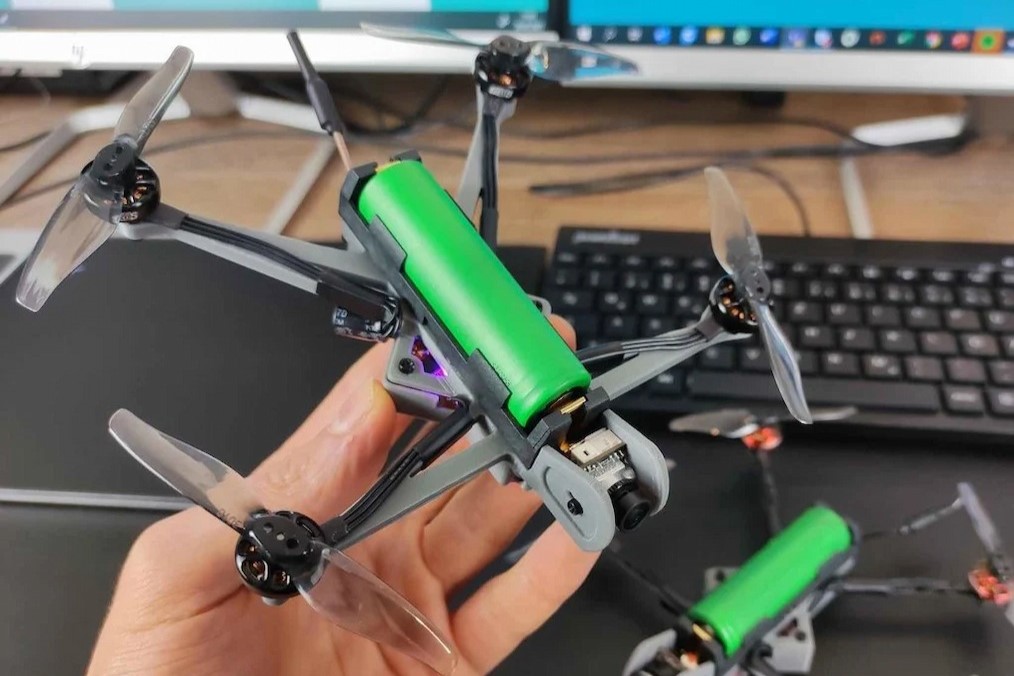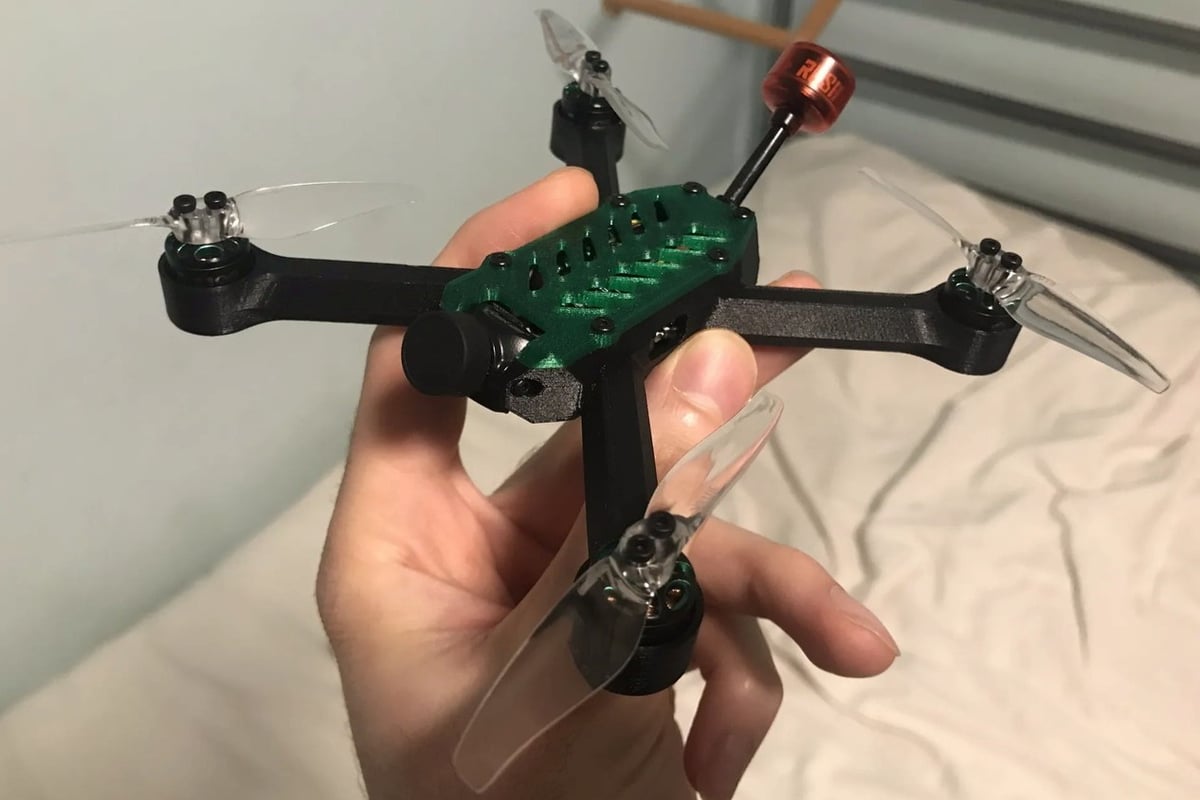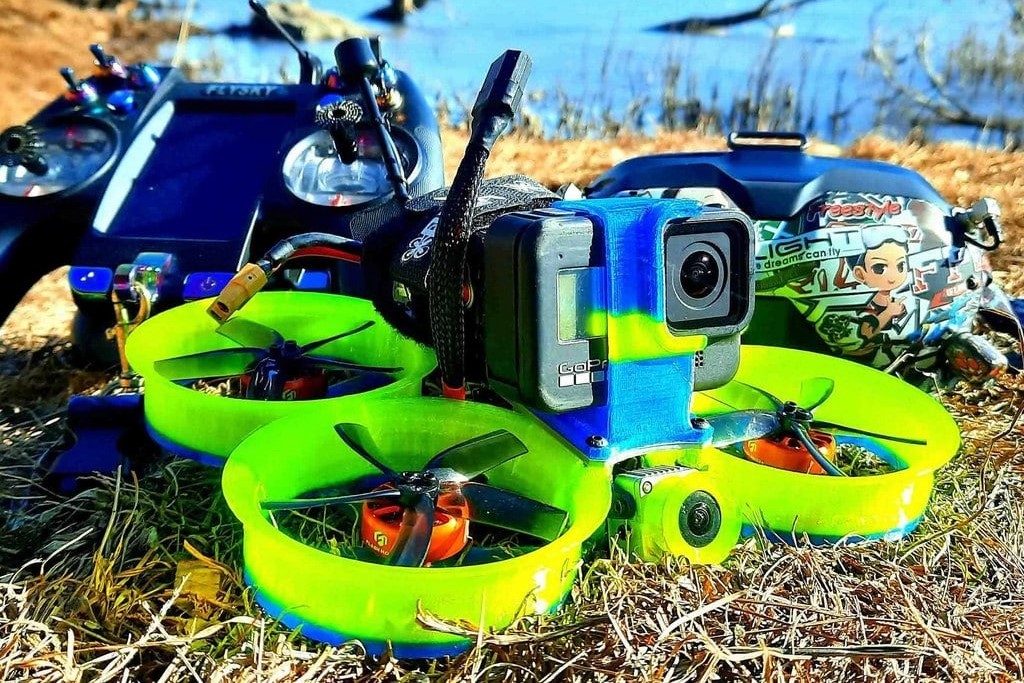FPV drones, or first-person view drones, are remote-controlled quadcopters with an onboard camera that sends video feedback to the pilot in real time, giving them the perspective of being in the cockpit of the drone.
The video feed is transmitted to goggles, a headset, a mobile device, or other display. This allows for much more maneuverability than flying line-of-sight, opening up a whole new world to RC enthusiasts. It also makes FPV drones the perfect candidate for cinematography and even racing.
3D printing has long been a part of the FPV drone hobby, with makers designing and printing their very own camera mounts, replacement canopies, and electronics protection.
As you will inevitably crash your FPV drone, many pilots have attempted to create 3D printed frames as replacements to offset the cost of replacing their carbon fiber frames after they break. This has been met with varying degrees of success, though a few frame designs have managed to find their way into the community and are now enjoyed by many.
In this article, we’ll be taking a look at some of the best FPV drone projects out there. Let’s get started!
Considerations

There are a few things to keep in mind when 3D printing and creating your own FPV drone.
One of the biggest downsides to 3D printed drones is the additional flexibility introduced into the frame. Standard FPV frames are made from strong carbon fiber, making them as stiff as can be. A 3D printed frame, regardless of which material you use, will not be as rigid as a traditional frame. This introduces oscillations into the body that can cause unwanted flight characteristics in most drones. A good 3D printed drone will do its best to make up for this through rigid and stiff designs.
Another key factor to consider is durability. We aren’t expecting a 3D printed frame to last longer than a carbon fiber frame. What we want is for the frame to withstand the force of your motors and not break after a single crash. Most of the frames in this list do their best to maximize durability, while others have easily replaceable parts.
Part availability is something to keep in mind for these builds. Having a comprehensive list of electronics and hardware parts needed to build your drone is very important, especially for beginner pilots. We’ve mostly chosen drones composed of easy-to-find parts, though some of the older projects may need some updated parts for replacements. Others provide you with the shell of the build, allowing you to fill in the electronics with whatever you see fit. This is often a plus for more advanced pilots.
Lastly, there’s the cost to consider. For many, the point of using a 3D printed drone is to reduce the price of buying a frame and mounting hardware. We have a good selection of price points that range from budget options to pricier, high-end drone projects.
So, let’s now take a look at some 3D printed FPV drones!
NanoLongRange

The NanoLongRange is a small form-factor drone that specializes in long-range flight. While many FPV drones use lithium-polymer batteries for high-performance movement, this build uses a single lithium-ion battery. What you lose in performance is gained back in weight conservation and flight time. You can expect to get about 20 minutes of flight time with this build, making it the perfect candidate for long-range flying and cruising.
The frame is entirely 3D printed in PLA+ and neatly houses all of the electronics. You will need a separate battery tray mounted on top of the frame unless you choose a remix with a built-in battery tray. One area in which this frame lacks is durability, as it’s rather small. This is often the case with drones that specialize in long-range flights, though this one in particular should be flown with care.
Building the NanoLongRange is a fairly straightforward process. All of the instructions and a complete part list can be found in the Thingiverse description. The most difficult part should be the wire soldering, as you’ll be working with much smaller wires than usual. If you need help, the designer has posted a helpful YouTube video. You can also check out all of the makes and comments for some tips.
- Price: ~$120, including battery, screws, and electrical supplies
- Who designed it: Dave_C_FPV
- How printable/popular is it: With 27 makes and 45 remixes, you can definitely make this drone yourself!
- Where to find it: Thingiverse
Goblin

Going up in size a bit, we have a 3-inch Goblin FPV Drone designed to be as sleek as possible. This size drone is best suited for 2S or 3S batteries, giving you just enough power to have fun cruising or doing tricks without the wind completely throwing you off course. The compact frame design provides decent protection for all of your electronics. Rest assured that he model has been through a few iterations, with the designer making improvements to overall performance and durability with every update.
It’s recommended to print the frame in carbon fiber PETG for the best results. While this does add some rigidity and durability to the frame, it still has a single-body design. If any of the arms on the frame becomes cracked or breaks after a crash, you will have to print out a completely new frame and move all of your electronics to it. Another obvious downside to this build is the lack of camera protection. If this becomes a problem, the designer also has other 5-inch drone options with multi-part designs that solve these issues.
While there is no video explaining the build process, the designer has left a comprehensive explanation in the Printables description, with recommendations for all of the necessary parts.
- Price: ~$120, including screws, battery straps, and a single 3S battery
- Who designed it: MichaelYurov_485764
- How printable/popular is it: Plenty of pilots are giving this drone a try, with 10 makes, over 1,400 downloads, and 4 remixes.
- Where to find it: Printables
Spyda 500 Quadcopter

By far the largest drone on the list is the Spyda 500 Quadcopter. This 19-inch drone isn’t an FPV drone in the traditional sense. It’s designed to be flown in line-of-sight without an onboard video transmitter, opting for a high-definition action camera or large camera gimbal to record the flight for future viewing. This is ideal for simple landscape videos or exterior real estate shots, as the size of this drone will make it as stable as can be in the air.
You’ll find plenty of makes and remixes of this build, allowing you to customize it to your needs. You can even add your own FPV camera. Customization seems to be key as well, as there is no concrete electronics list available. Many makers have recommendations for their preferred builds, so you can check out a few before deciding which one you want to build.
This build is only recommended for advanced pilots. While the frame assembly is simple enough, only requiring a few screws for each of the arms, having to source all of the parts on your own can be a daunting task for beginners. There is plenty of room to mount your electronics of choice on the frame, giving you options for upgrades down the line.
- Price: ~$200, with no upper range for creativity
- Who designed it: Gyrobot
- How printable/popular is it: With a whopping 58 posted makes and 44 remixes, this drone has plenty of fans.
- Where to find it: Thingiverse
Ultimate Cinewhoop

Cinewhoops are smaller drones specially designed for safe cinematic recording using a mounted action camera, with air ducts surrounding the propellers to reduce the chances of harming anything or anyone near the drone. The Ultimate Cinewhoop build is aptly named, as it takes some of the best features found on community-favorite Cinewhoop frames and combines them for an all-in-one experience.
Many Cinewhoop frames already use TPU prop guards, making it a natural choice for this build. The main difference is the 3D printed top and bottom plates that are used to mount the electronics. You will want to use a tough filament choice for these two pieces, either PLA+ or any type of carbon fiber blend. While the frame is designed to hold a Caddx Vista video system, it has all of the mounting holes needed to convert to whatever video system you choose.
The frame is designed to be as durable as possible, but there are also plenty of options for adding extra support throughout the build. Custom carbon fiber top plates and arm reinforcements are available. As far as parts go, this frame gives you the flexibility to come up with your own build, though there are some helpful recommendations in the description.
- Price: ~$250 for an analog build
- Who designed it: Xarhvid
- How printable/popular is it: There are five shared makes and two remixes on Thingiverse so far.
- Where to find it: Thingiverse
7-inch Long-Range

If the NanoLongRange build wasn’t big enough for you, this next drone might be what you want. The frame is designed to support 7-inch FPV drone equipment optimized for long-range flights. The lightweight approach aims to save as much of your battery power as possible for increased flight times.
The body of the frame comes with a built-in battery compartment that doubles as an action camera mount, sized for the RunCam 5 Orange camera. The arm thickness looks to provide a bit of durability but lacks any additional protection. You’ll also notice that the frame is once again a single-body design, so be prepared to replace the entire frame should a single arm break. Carbon fiber filament blends are recommended for the best possible results.
There is room for whatever type of hardware you choose to mount on this build, including space for a GPS module, which is very nice to have on these long-range drones. With the right battery, you can expect around 40 minutes of total flight time with a range of about 10 miles.
All of the CAD files, as well as a list of the components needed for this build, are available to anyone who wants to replicate this drone. You should be comfortable soldering and have a prior understanding of the electronics, as there is no tutorial available.
- Price: ~$370, not including the action camera
- Who designed it: GoEngineer
- How printable/popular is it: With over 75,000 views on YouTube and plenty of positive comments, this drone should be replicable at home. If you run into any trouble during the build, the creator is responsive to questions in the comments section.
- Where to find it: YouTube
License: The text of "3D Printed FPV Drone: 5 Projects to Create Your Own!" by All3DP is licensed under a Creative Commons Attribution 4.0 International License.
